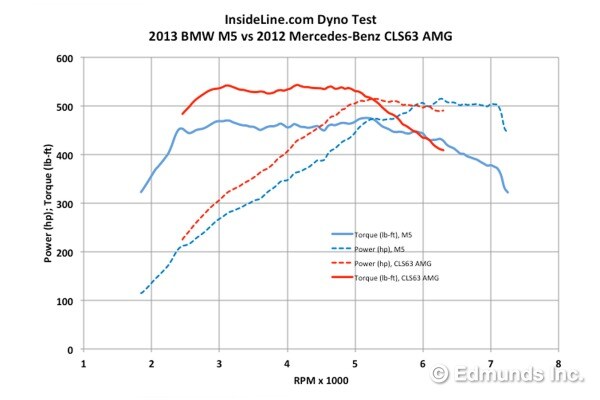
To distort a Fletch-era Chevy Chase quote, "It's all turbos these days." If you want performance and fuel efficiency — and really, who doesn't — turbocharged engines are your huckleberry. And so it is with BMW's flagship performance sedan, the 2013 BMW M5, which packs a stonking twin-turbo V8 in lieu of the erstwhile model's normally aspirated 5.0-liter V10.
The new M5's S63Tü V8 is the kitchen sink of modern engines. It's a Valvetronic-equipped direct-injected 4.4-liter V8, and nestled in the vee of the engine are two twin-scroll Honeywell Garrett turbos, tipping off its "hot side inside" configuration. The M5's unique cross-bank exhaust manifold affords its twin-scroll turbines ideal cylinder groupings, unlike the traditional exhaust manifolds of the seemingly similar Audi 4.0T V8.

Charge air is cooled by two water-to-air intercoolers, which are managed by an elaborate system of pumps and heat exchangers. Factory ratings are 560 horsepower from 6,000-7,000 rpm and 500 pound-feet of torque, delivered from 1,500-5,750 rpm.
We strapped a six-speed manual transmission-equipped 2013 BMW M5 to the Dynojet chassis dyno at MD Automotive and measured this:

Boost builds cleanly from very low in the rev range, the engine behaving in a linear manner despite a peak of 22 psi boost pressure. Torque as measured at the wheels reaches its maximum 475 lb-ft at 5,150 rpm, but since the torque curve is less a curve than a slab, there's plenty on tap when the tach is showing small digits. Peak power is... well, we'll get to that.
The torque tabletop is more or less constant from 2,500-5,200, a span that's a bit narrower than the factory claims for reasons we've delved into previously. Essentially, engine dynos load engines differently than do chassis dynos, so on the Dynojet we never see the wide torque "plateaus" claimed by manufacturers of turbocharged engines. In a nutshell, what we see here is normal and expected.

What wasn't normal and expected is the way the M5 behaved while on the dyno. Its power at high revs was anything but consistent. Each dyno pull showed less peak power than the prior one, a trend that was observed for eight consecutive pulls.
Heat-soaked intercooler, you might guess, and so did we. Nope. Immediately after the eighth pull — when the apparent heat soak would have been at its worst — all of the intercooler plumbing and heat exchangers were cool to the touch, suggesting the culprit was elsewhere.
Take a look at the M5's power degradation here:

That's a spread of more than 50 hp, as measured at the peaks.

On the ninth dyno pull the result jumped back up, neatly splitting the difference between the lowest and highest result observed previously. Whatever was causing power to steadily ratchet downward apparently took a nap. Stabilized output is our usual goal when dyno-testing cars, and the M5 didn't achieve it. Nevertheless we were out of time and as that ninth pull was something of an average of the prior eight, that's what we went with as the representative result: 514 hp as measured at the wheels. But keep in mind the 50-hp spread.
BMW's crosstown rival experienced no such power degradation on the dyno. The 2012 Mercedes-Benz CLS63 AMG we recently tested on this very dyno — using the same methodology — was unfazed. Pull after pull, it actually increased in power before finally stabilizing. The CLS63 AMG, too, is powered by a twin-turbo direct-injected V8, though it sports 1.1 liters more displacement than the BMW. The Benz also has conventional single-scroll turbos.
Here's how the 2013 BMW M5 compares to the CLS63 AMG on the dyno:

It's the classic distinction of cubes versus revs. The CLS63 has the M5 covered until 5,900 rpm, at which point the M5 flexes its ability to breathe at high revs. Peak power is the same for both cars, so pick your poison.


The manufacturer provided Edmunds this vehicle for the purposes of evaluation.
